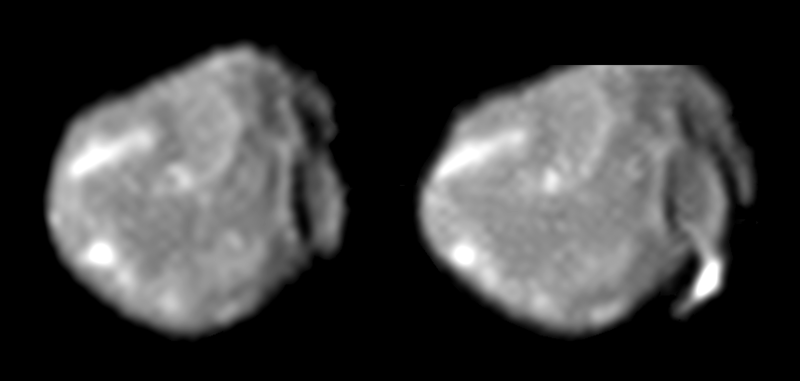http://www.planetary.org/blog/article/00003458/ wrote:
JUICE: Europe's next mission to Jupiter?
The Planetary Society Blog by Emily Lakdawalla, Apr. 18, 2012
<<The Twitterverse is buzzing this morning with news that the Science Programme Committee of the European Space Agency has recommended that the next large European mission be JUICE, a mission to explore the three icy Galilean satellites and eventually to orbit Ganymede. The recommendation is not binding; it must be voted upon (a simple majority vote, according to BBC News), at a meeting of the Science Programme Committee, consisting of representatives of all 19 ESA member states, on May 2. The committee is likely to green-light this recommendation, but it shouldn't be taken as a certain decision just yet.
JUICE is being recommended over ATHENA (an x-ray observatory) and NGO (a gravitational wave observatory). It would launch in June 2022, enter Jupiter orbit in January 2030, and end in Ganymede orbit in June 2033. It is a concept that has been modified from JGO, the Jupiter Ganymede Orbiter, originally conceived as Europe's half of a US-Europe two-spacecraft mission to Jupiter, where NASA had originally proposed to provide a Jupiter Europa Orbiter. NASA canceled its plans to participate in that mission just as it canceled its participation in ExoMars more recently, and as with ExoMars, ESA appears ready to go forward without the USA. In fact, ESA has modified the originally proposed JGO mission to incorporate some of the science goals that would have been accomplished by NASA's Europa mission.
Here's the mission description and profile from the ESA document:
Science goals: The JUICE mission will visit the Jupiter system concentrating on the characterization of Ganymede, Europa and Callisto as planetary objects and potential habitats and on the exploration of the Jupiter system considered as an archetype for gas giants in the solar system and elsewhere. The focus of JUICE is to characterize the conditions that may have led to the emergence of habitable environments among the Jovian icy satellites, with special emphasis on the three ocean-bearing worlds, Ganymede, Europa, and Callisto. The mission will also focus on characterizing the diversity of processes in the Jupiter system which may be required in order to provide a stable environment at Ganymede, Europa and Callisto on geologic time scales, including gravitational coupling between the Galilean satellites and their long term tidal influence on the system as a whole.
Mission profile: The mission will be launched in June 2022 by an Ariane 5 ECA and will perform a 7.5 yr cruise toward Jupiter based on an Earth-Venus-Earth-Earth gravitational assist. The Jupiter orbit insertion will be performed in January 2030, and will be followed by a tour of the Jupiter system, comprising a transfer to Callisto (11 months), a phase studying Europa (with 2 flybys) and Callisto (with 3 flybys) lasting one month, a "Jupiter high-latitude phase" that includes 9 Callisto flybys (lasting 9 months) and the transfer to Ganymede (lasting 11 months). In September 2032 the spacecraft is inserted into orbit around Ganymede, starting with elliptical and high altitude circular orbits (for 5 months) followed by a phase in a medium altitude (500 km) circular orbit (3 months) and by a final phase in low altitude (200 km) circular orbit (1 month). The end of the nominal mission is foreseen in June 2033.
Spacecraft description: The spacecraft is 3-axis stabilised, and powered by solar panels, providing around 650 W at end of mission. Communication to Earth is provided by a fixed 3.2 m diameter high-gain antenna, in X and Ka bands, with a downlink capacity of at least 1.4 Gbit/day. To perform its tour of the Jupiter system the spacecraft will have a ΔV capability of 2700 m/s, and the shielding will limit radiation to 240 krad at the centre of a 10 mm Al solid sphere. The spacecraft dry mass at launch will be approximately 1.8 tons. While the actual payload will be chosen through a competitive AO process, the study has identified a model payload based on a suite of 11 instrument totalling 104 kg. These comprise cameras, spectrometers, a sub-mm wave instrument, a laser altimeter, an ice-penetrating radar, a magnetometer, a particle package, a radio and plasma wave instrument as well as a radio science instrument and ultra-stable oscillator.
A separate document, a presentation to the Outer Planets Assessment Group meeting in March 2012, details the model payload (thanks to Van Kane for this link):
- Narrow-angle camera
Wide-angle camera
Visible Infrared Hyperspectral Imaging Spectrometer
UV Imaging Spectrometer
Sub-millimeter Wave Instrument
Magnetometer
Radio and Plasma Wave Instrument
Particle and Plasma Instrument - Ion Neutral Mass Spectrometer
Laser Altimeter
Ice Penetrating Radar
Radio Science Instrument
This selection -- if it is accepted -- represents a big win for planetary science and a big loss for space-based astrophysics in Europe. Which is, one can't help but notice, opposite to what the currently-proposed NASA budget represents.>>
 Jupiter Unplugged
Jupiter Unplugged
